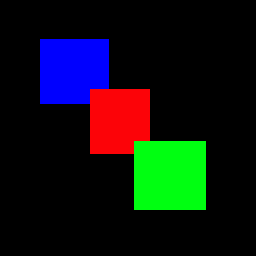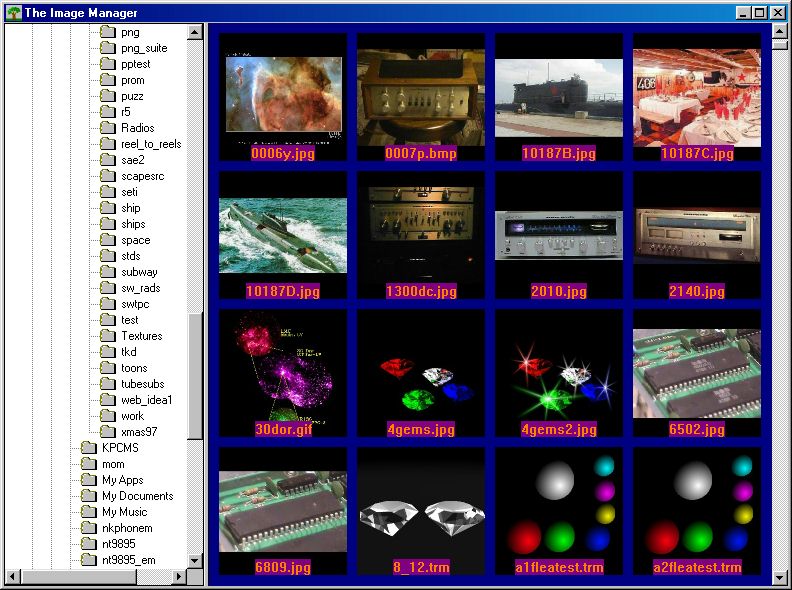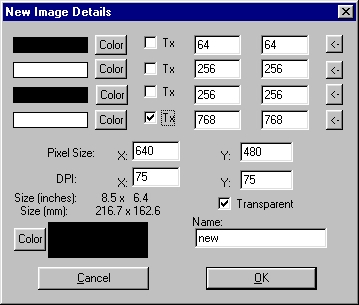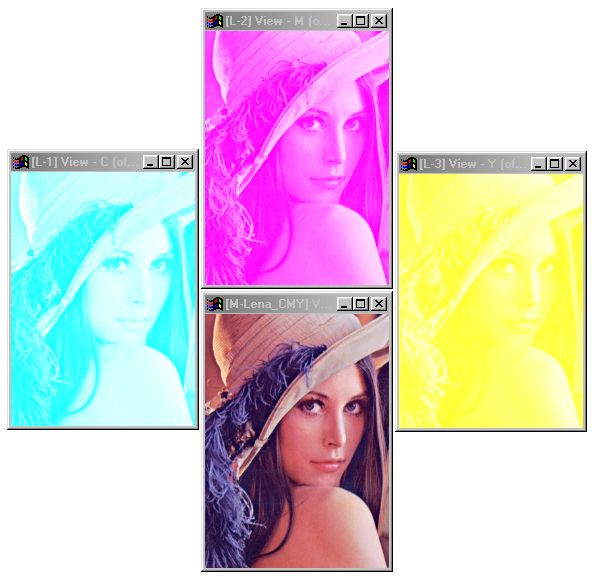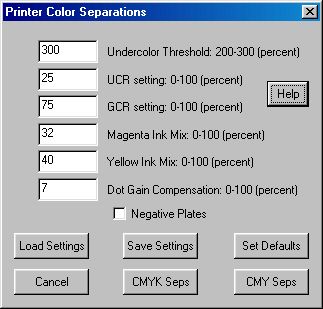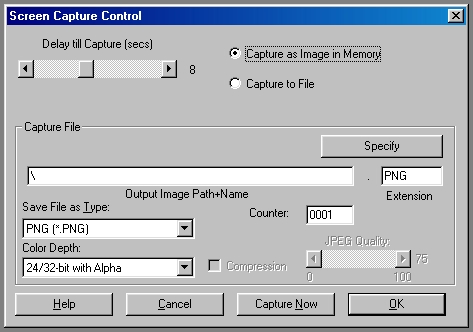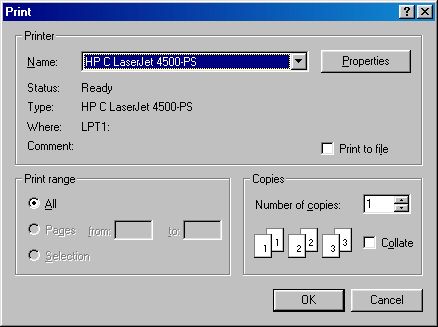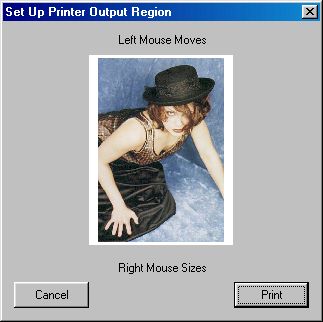| This is a child page. You can use Parent in the quick nav bar at the top or the bottom of the page to navigate directly back to the parent of this page. Some child pages are more than one level deep, and in that case will require more than one Parent click to reach the outermost document level. |
§ 14.2 - The File Menu
§ 14.2.1 - Load Image and the MRU submenu
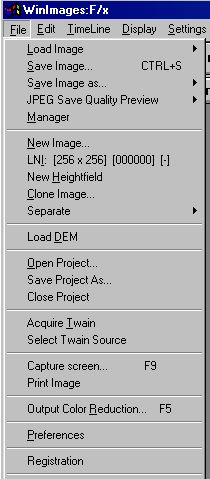
This option will load an image into a view. The Load Image item is operated through a series of submenus that detail a number of recently used (hence the term MRU... Most Recently Used) filesystem locations. This allows you to quickly and easily get to your image files without having to navigate, and re-navigate, and re-re-navigate...
F/x loads the file types which are listed below.
The image types that are presently loaded are as follows:
- Windows Bitmap Files (BMPs or DIBs) - Windows BMP (or DIB, Device Independent Bitmaps) can be from 1 bit (2 colors) through to 24 bits (16.8 million colors) and may be compressed or uncompressed.
- Targa (TGA) files - Targa files can have up to 16.8 million colors and may include an alpha channel (or transparency mask). F/x also supports the loading and saving of Targa 2 files. These files are 24 bit Targa files that also contain a full color postage stamp sized representation of the image file. This thumbnail image is saved as part of the Targa 2 files, and is used in the exposure Sheet. These files also contain any annotation or author information specified prior to saving. This information is specified in the View menu's Change image information option.
- TIFFs - The TIFF (Tag Image File Format) has a very broad range of possible types. The program loads all the TIFF types we have been able to find, including 1 to 24 bit RGB images, CMYK ( Cyan, Magenta, Yellow, Black ) color separations, Intel and Motorola formats and images directly from Macintosh computers.
- PCX - PCX images are typically created by Paint programs on the PC. The format was originally introduced by Zsoft for their PC Paintbrush program. We read from 1 (2 color) to 8 bit (256 color) PCX images.
- GIF - The GIF format, originating from Compuserve, is no longer officially supported by Black Belt Systems. UniSys, who owns the patent on the compression in GIF and TIFF, has placed new restrictions on the format that limit its use.
- Amiga® IFF/ILBM - The program loads 24 bit IFF/ILBM images. IFF is a file format used on Amiga® computers and under the new stand-alone Amiga® operating system.
- I-raw graphics /RAW - I-raw is a simple 24 bit image format.
- RGB - This is a SGI based image format for full color images.
- PSD - This is the Photoshop® format. F/x will load both flat and layered PSD files. PSD files that contain "blend masks" will have the blends promoted to local layers in Grey Mask mode immediately superior to the layer that contained the blend. This produces the same end result as a blend does inside Photoshop®. R6's PSD loading technology is based upon the Photoshop® PSD specification version 4.0. R6 does not use PSD "adjustment layers", although it does create a blank white layer, disabled, where the adjustment layer is inside the PSD layered image stack. You can in many cases create an adjustment layer using F/x's adjustment layers, but this must be done manually.
- Olympus RAW image file format - this is a digital camera format
- Canon RAW image file format - this is a digital camera format. This support is implemented as an importer plug-in.
- PPM - PPM is an intermediate format used in the conversion of many formats via the Portable Bitmaps Utilities.
- Toaster Framestores (.FS) - The Framestore format is a 16-bit video image format used on the Amiga® in conjunction with NewTek®'s Video Toaster hardware. F/x supports both compressed and uncompressed Framestores.
- Animator FLI and FLC - Any frame within an Animator FLI or FLC animation file can be loaded as the view. FLI/FLC sequences use up to 256 colors per pixel.
- AVI - The AVI format (Video for Windows) can be loaded in the Windows 95, 98 and Windows NT versions of F/x. Saving of this format is available to all versions of F/x. AVI files can be loaded as a single image view, or processed through the timeline. F/x can load and save both 8-bit and 24-bit AVI files using any 32-bit resident CODEC.
- F/x FiLMstrip frames - WinImages programs save filmstrips as a 24 bit (16.8 million color) sequence. You may load one of the frames as your current view.
-
TRIM image format - The TRIM image format was developed by Black Belt Systems. It is a lossless, very high compression, 24-bit / full color + Alpha format for continuous tone images.
Typically, 24-bit images saved in this format will yield file sizes than any other lossless image format we know of except PNG; PNG can achieve very similar compression ratios. Because TRIM is a file format that is limited to Black Belt Systems software, we suggest you use PNG rather than TRIM as your preferred lossless image save format.
Until PNG was developed, TRIM was the highest compression lossless format in existence; the format is now only included for compatibility with previous versions of our software. We will no longer extend this format; instead, Black Belt Systems joins the thousands of developers who promote and support the PNG (and MNG) file formats.
-
JFIF/JPEG - F/x loads and saves non-progressive JPEG files that are in JFIF format. JPEG is a file format which is "lossy", which means that when the image is changed into JPEG format, some of the image information is lost. For this reason, JPEG images will not be of as high a quality as you should expect from a 24-bit file format. Note that the compression used by the JPEG process is extremely effective; so much so that images may be only 1/50th of their uncompressed size. Because of this, you may find that a JPEG file which appears to be quite small uncompresses to a very large image, which you may not be able to load into F/x without having additional RAM memory available.
The JPEG (Joint Photographic Experts Group) format images are highly compressed, 24-bit color inaccurate images. No mask or alpha channel information is saved; the image compression method used is "lossy". F/x's save module provides you with the ability to set the compression used from light to heavy. More compression results in more loss of image detail.
JPEG is quite useful for some things... things you aren't too concerned about... and absolutely the worst thing to use for others. Consider: JPEG loses some quality when it compresses an image. Not a lot, if you use maximum quality (minimum compression), but still, some loss of quality occurs. If you're a scientist or a doctor, don't think "loses quality", instead think "loses and changes data"! Or, if that's not a pointed enough statement, think, "Lawsuit!"
Here is an example of what happens to image data when saved in JPEG:
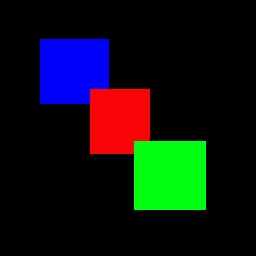
This is a JPEG of the same image, saved in maximum quality.
If you look at the edges, you will see where the losses occur.
See below for a zoom.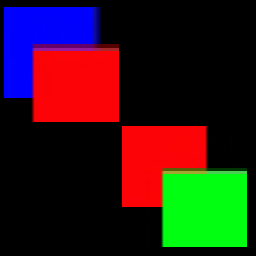
These three images tell the entire story. The original image was sharp and clear; the JPEG image, though saved in the highest possible quality, is changed radically from the original. JPEG is very bad at dealing with sudden changes in image content. It does better with smooth images, but not that much better, actually. If you take an image, save it in JPEG, and the subtract the saved image from the original, you'll see a lot of differences how up. Subtle details are lost.
Consider what happens if you're working on an image over a number of sessions. Each time you go through a save and load sequence in JPEG format, it deteriorates a little more (or a lot, if you compress it a great deal). The lesson, and the rule that comes from it, is obvious: Don't ever use JPEG as a storage format for an image you're working on, or for an image that will be used in another image (unless you positively know that the loss of quality won't matter, for whatever reason.) JPEG is really good for archival storage of images you like, but aren't "serious" about. On minimum compression, a single use of the JPEG technique on an image will not seriously degrade it visually. And that's what you'd normally do with an archived image. Store it once, then load it as you please to view it, as many times as you like. If you will be doing multiple loading and saving of a particular image, you should use the PNG format. PNG will give you at least twice the compression of a standard IFF24 or TIFF with absolutely no image loss, so it is perfect for ongoing projects.
The JPEG file saver has an option at the bottom of the Save Image dialog called JPEG Quality. This control allows you to specify the quality of the resulting saved image. The quality is measured on a scale from 0 (worst quality) to 100 (best quality). Increasing the quality will increase the size of the output file (less compression), and decreasing the quality will decrease the size of the output file (more compression). Remember, the lower the quality the more compression you will achieve, but this will be at the expense of losing additional image information.
§ 14.2.1.1 - Loading an Image File
Loading a file in F/x is very simple. First, select the Load Image... option in the File pull down menu, and then navigate sideways into the MRU submenu. Pick the directory you wish to use. If you plan to navigate to another directory entirely, just pick the closest one and work from there. This process will present you with a file dialog which allows you to specify the file's path and name. The file will be loaded when the file name is clicked on twice or when the file is selected and OK is pressed.
Image files can also be loaded by using Drag and Drop from Windows Explorer. Drag and Drop is a means of loading files into a program directly from Windows Explorer. In F/ximage files can be dragged into the view windows.
To load an image using Drag and Drop:
- With the F/x program opened, open Windows Explorer. Make sure that there is at least one image view open.
- Make sure that both Windows Explorer and a View window are visible.
- Click down on the image file you want loaded.
- With the mouse button still down, move the pointer to the image view in F/x.
-
Release the mouse button over the window. When dragging files, the pointer will look like if the file can be dropped into the underlying window, and if it cannot be dropped there. You can also load a group of files by first selecting the files, and then using the above steps load the files into F/x.
If a file is not identified as a known image type, the message: "Image file type is not recognized" is displayed.
§ 14.2.1.2 - Thumbnails
F/x, as of version R6, includes a high speed integrated thumbnailing system. Thumbnails can be generated on the fly, or they may be stored in local subdirectories for instant access. Here is the Load dialog with the thumbnailing section to the right of the main dialog:
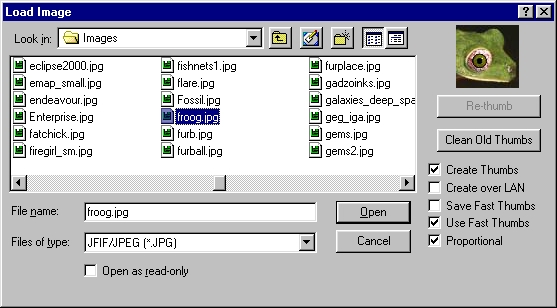
Create Thumbs, when checked, tells F/x you want to see thumbnails.
Create Over LAN tells F/x that you want to create thumbnails even when you are connected to another machine (make sure this is ok with the machine's owner, if you have save checked also.)
Save Fast Thumbs tells F/x that you want it to create a directory inside each image directory you visit in the dialog, and inside that directory, you want it to store thumbnail images. The benefit of this is significant: the next time you pass over that image in the dialog, instead of reading the image and generating a thumbnail, F/x will get it from the thumbnail subdirectory and it will appear almost instantly. You can, of course, generate a lot of thumbnails this way!
Use Fast Thumbs tells F/x to use the fast thumbnails it has stored. Usually, you want this behavior.
Proportional tells F/x that you want the thumbnail to be the same shape as the image. This looks more normal, but uses less of the thumbnail area for non-square images. You might prefer to have a distorted thumbnail, since you see more of the image that way. You decide.
Re-Thumb tells F/x to generate a new thumbnail over the stored fast version. You might want to do this if you know the image has been updated by another application.
Clean Old Thumbs tells F/x to read the entire fast thumbs directory, match the thumbnails inside with the images in the directory you're working in, and if there is not a matching image, to delete the thumbnail. This helps you keep your thumbnail directories from getting out of hand over time. Every once in a while, when you've got a minute or two to spare, press this button.
§ 14.2.2 - Save Image
The Save Image option will save an image in the format that it was originally loaded in. For example, if the file was loaded as a JPEG, F/x will automatically re-save the image using the JPEG format. If you would like to change the output format, you should select the Save Image As option. This option allows you to save an image with a different file format and bit depth. If multiple images are loaded, F/x will present you with a dialog listing the images that may be saved; choose the one you want, and then save it.
§ 14.2.3 - Save Image As
Save Image as... allows you to save an image. The image will be saved in the format specified in the Save File as Type option in the Save Image dialog. F/x will present you with a list of the current images in the program. After you have selected an image from the list you can then specify the directory path and file name to be used for saving the image. There are also controls to alter the file format, color depth, and compression. After you have specified the desired file format, set the color depth, and compression if any is available for the current file format. The Output Color Reduction (Color Selection and Dithering methods) can be set before saving an image in the Output Color Reduction option in this menu.
Save Image As... uses the same type of MRU submenu as does Load Image. See Load Image, above, for an explanation.
Current save format options include:
- 32-bit layered ELF images
- Full color Windows Bitmap
- 256 color Windows Bitmap
- 16 color Windows Bitmap
- 2 color Windows Bitmap
- Animator FLIC animation
- 24-bit Amiga IFF/ILBM
- JFIF/JPEG (lossy... not recommended except as a not-to-be-edited storage choice)
- 24-bit PCX (full color)
- 256 color PCX
- 16 color PCX
- 2 color PCX
- Targa 24/32 bit (full color with alpha)/ Targa 2
- Uncompressed or Compressed Targa
- TIFF (full color, plus alpha)
- TRIM (full color, plus alpha)
- 256 color AVI
- 16-bit Toaster Framestore (video domain color)
- 24-bit AVI, any resident 32-bit CODEC
- 8-bit AVI, any resident 32-bit CODEC
-
8-bit GIF (see also PNG)
 Tip:
Tip: You can save GIF stills that utilize GIF's limited on/off transparency by following a few simple steps:
- Make sure image has an alpha channel ? Unknown Style "me" ? Make Alpha, "Replace entire channel" will do this.
- You need to create an easily recognizable and highly disjoint "key color" in the image
- Using the magic wand, fill this with transparent alpha (Make Alpha, "subtract from alpha channel")
- Using Build Palette op, turn all checkmarks on:
-
✓ Clear
✓ Accumulate
✓ Generate palette
✓ Render transparent color - Using "entire image", build a palette using the operator
- Open the Color Reduction settings, and RIGHT-click on the KEY color in the palette
- Set the render settings so that "Use Current Palette" is the choice
- Save the GIF
- 8-bit GIF animations (see also MNG)
- 8-bit PNG
- 24-bit PNG
- 32-bit PNG (RGB, plus Alpha)
- 8-bit MNG animations
If you load and save any image with more colors than 256 using an image format with less than 24 bit, full (16.8 million) color, your image quality will always be compromised.
To save to an Animator FLIC or Video for Windows AVI animation, each frame must be saved in sequence. Therefore, you must set the Save Result option in the Sequence Controls so that each frame gets saved into the animation file as it is created. This means that you will also need to specify that the file type to be saved as an FLI/FLC or AVI.
If you need to save transparent GIF's, this can be done by using special palette control techniques. The rendering controls (under the main file menu, Output Color Reduction) contain a list of all colors selected for the rendered palette, and the color you right-click upon prior to a save will be the transparent color. Of course, you must ensure that this color exists in the image only where you want the image to be transparent; you can do this by picking a color that is very different from any in the image.
You can also save GIF and MNG animations as a special feature of the filmstrip. This option is available in the filmstrip menu.
§ 14.2.4 - JPEG Save Quality Preview
This menu option creates a special save window that allows you to see the image as it exists prior to saving, an image of the saved result in JPEG so you can evaluate the damage from a normal perception point of view, and an error display that picks out the damage to the image and amplifies it so you know where to look.
You can pan around the image by dragging the images with the left mouse button, and there are some useful cue displays such as download time and file size available with each test image you generate. In order to create the test images, FX actually creates an actual JPEG file; you can change where it does this. The test file is deleted when you exit the preview window.
The left pane is the original image, the center pane is the saved test file, and the right pane is the damage amplifier.
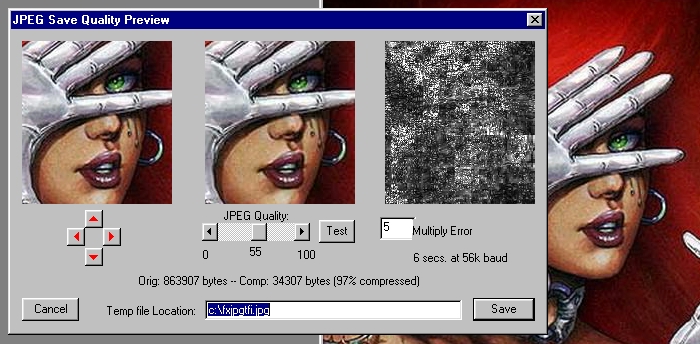
JPEG Quality Preview uses the same type of MRU submenu as does Load Image. See Load Image, above, for an explanation.
§ 14.2.5 - Manager
This option opens F/x's image file manager. With this tool you can perform a number of useful operations on images and browse through them using thumbnails. For details on the file manager, please see the page describing the File Manager in detail.
§ 14.2.6 - New Image
This option will create a new image and place it in a view. The New Image dialog allows you to specify the name, dimensions, dots per inch (DPI) setting, and the color of the new buffer.
The Name field allows you to specify a name for the new image. The name of the new image will be provided by the program if you do not specify one. The Pixel Size setting allows you to specify the size of the new image in pixels. This setting will default to the last values that were entered. The DPI setting allows you to alter the Dots per Inch of the new image. You will notice that as the Pixel Size and the DPI are altered, the size in inches and millimeters will change to reflect the new size of the image. The Specify Initial Color allows you to select the color of the new image. The control, when pressed, will provide you with a palette of colors to choose as the new image color. The color will default to the last selected color. If you select the Transparent option, the image will be created with an active, completely transparent alpha channel.
At the top of the dialog are four handy presets that F/x will remember when you exit the program and restart it later on. These presets may be chosen by simply pressing the arrow button at the right of the preset; this will immediately exit the dialog using those settings.
§ 14.2.7 - LNI — Last New Image
This menu entry will immediately create a new image using the settings last made in the New Image dialog. This is useful if you are working with a standard image size for a particular project.
§ 14.2.8 - New Heightfield
This provides a general facility for generating heightfields, clouds and many other types of textures.
For more information on the texture generator, Click Here.
§ 14.2.9 - Clone Image
The Clone Image option will copy or clone any image that you select. Cloned images will have the same aspect ratio, pixel resolution, and DPI as the original image. Remember that this clone is an exact copy of the original, and therefore requires the same amount of memory.
The clone command is also available from the Quick Ops context submenu for image views.
See Also: Making More Memory Available
§ 14.2.10 - Separate Image
This menu item offers four sub-menu choices. The first will separate the selected image into red, green and blue channels. The second will separate the selected image into cyan, magenta and yellow channels, and the third will separate the image into cyan, magenta, yellow and black channels. The fourth, Printer, we'll discuss a little later.
The separated image created by the first three selections is constructed using layer modes to recombine these separated channels into a full-color image.
The fourth choice, Printer, can create professional-quality color separations. For details on the color separation process, please see Appendix M
§ 14.2.11 - Load DEM
This is a specialized loading tool meant for working with heightfields. A DEM file is a file that contains floating-point representation of terrain heights. USGS DEM files can be loaded.
§ 14.2.12 - Open Project
The Open Project option is used to load a previously saved F/x project. This will open all of the image files that were loaded in F/x when the project was last saved using the Save Project As command, as well as setting most of the operator variables to the values they contained at the time of the project save. With release 4.0 and later, F/x project files also contain TimeLine file information.
§ 14.2.13 - Save Project As
This control will save the current project. Save Project As will remember all of the image files that are currently loaded and most operator settings. This project file can then be reloaded using the Open Project option. If you are working with a timeline, F/x will ask you for a save name and path for the TimeLine file, and will include this information as part of the project file.
§ 14.2.14 - Close Project
If a current project has been set up, F/x will ask whether the project should be saved. Note that the filmstrip is not saved with the project but should be saved separately if desired. If the settings files have changed, the program will save them before saving the project file.
§ 14.2.15 - Acquire Twain
If you have Twain interface components in your system, such as scanners, digital cameras, video digitizers and so on, this menu command will allow you to capture an image from one of the available sources. Use Select Twain Source (described next) to choose which one.
§ 14.2.16 - Select Twain Source
This menu command will open a dialog that shows all of the available Twain sources in your system. Choosing one sets it as the source that will be used by the Acquire Twain command, described above.
§ 14.2.17 - Capture Screen
The screen capture option allows you to set up a screen capture from within F/x. The screen capture utilities can be used to capture F/x's screen immediately, or it can be delayed so that you may capture the screen of another application. You also have the option of capturing into memory (an image view in F/x), or capturing into an image file. Once a screen has been captured, it can be treated like any other image in F/x. This means that you can apply a Color Fill to a selected region, or apply a Dome to the Tool Bar. Once you have made any needed modifications, the image can be saved using the File menu's Save Image As... option.
Step by Step Instructions for Capturing Screens
- Enter the File menu and select Capture Screen, or press the F9 key (Quick Capture) to capture the current F/x program screen using the default screen capture settings.
- If you open the Screen Capture Control dialog, then specify any needed time delay, where the image is to be captured (image view or image file), and any other file related details.
- Select the Capture Now option to capture F/x's screen using the current screen capture settings, or to use the time delay to capture another application's screen. Pressing OK will not capture the screen. This will instead confirm any changes that you made to the screen capture dialog, and save them for use with the Quick Capture keystroke (F9).
- If you are capturing F/x's screen, simply wait until the screen capture has completed (watch the progress bar), If you are capturing another program's screen with a time delay, use ALT+TAB switching to bring the application to be captured to the front. You will need to wait until the timer has elapsed, and the screen has been captured. You can then switch back to F/x, and view the newly created capture.
Screen Capture Controls
Delay till Capture: This control allows you to specify the delay time (in seconds) before the screen capture occurs. This allows you time to switch to another application, or to rearrange F/x's screen elements. The delay can range from 0 (no delay) to 15 seconds.
Capture to Memory/File: These radio buttons allow you to select if the file will be captured and placed into an image view in F/x, or saved to an image file. If Capture as Image in Memory is selected, then the screen capture will be placed into an image view in F/x. If Capture to File is selected, then the screen capture will be saved into the specified file name and format located in the Capture File section of the dialog.
Specify: Pressing this button will access a standard file dialog which can be use for setting the image path, image name, file type, and file type options. After you have set these parameters, press the Ok button to confirm the changes and return to the dialog. You can alter any of these parameters from within the Screen Capture dialog by changing the appropriate text entry field, or drop down box entry.
Output Image Path+Name/Ext: This text entry field is used to specify the image path and file name for the screen capture. This information will be used to determine where the capture will be saved on your hard drive, and the image file name. The extension is automatically determined by the file type. For example, Targa files are saved with a .TGA extension by default. This can be changed to any extension by entering in the desired extension in the Extension box. It is important to remember that you are required to have a complete path and file name for any file that is to be saved. If you are unsure about the image path or name, you should use the Specify button to select a path and file name.
Save File as Type: This drop down box contains a list of all of the available save types in F/x. The file type that is selected will be used as the file format for the screen capture. This save type is changed by simply double clicking on a new file type. Each new file type will have various options associated with it. These options are controlled through the Color Depth and Compression controls. For example, if your Save Type was set to Bitmap, then you would have the option to save it as 24 bit, 16 bit, 8 bit, 4 bit, or 1 bit bitmap that can be compressed or uncompressed.
Color Depth: This drop down box contains all of the available bit depth (number of possible colors) for a file type. Each file format in the Save File as Type drop down box has different bit depths associated with it. Some formats (like JPEG) only have one bit depth (24 bit). Other formats (like Bitmap) have multiple bit depths for saving. In most cases you will want to select a 24 bit depth for high quality screen captures.
Compression: The compression check box allows you to select compressed or uncompressed for an image file format. It is important to remember that not all image file formats support compression. If the file format does support compression, then the check box will be available. If no compression method is available for the current file type, then the compression check box will not be available.
JPEG Quality: The slider is only available for JPEG image files. This control allows you to specify the quality of the resulting saved image. The quality is measured on a scale from 0 (worst quality) to 100 (best quality). Increasing the quality will increase the size of the output file (less compression), and decreasing the quality will decrease the size of the output file (more compression). Remember, the lower the quality the more compression you will achieve, but this will be at the expense of losing image information.
Counter: The counter will put an automatic four digit extension on to the current capture file name. This allows you to capture a number of sequential screens that have an identifying number. This number is automatically incremented whenever a new screen is captured. This counter can only be reset by entering a zero value.
§ 14.2.18 - Print Image
This menu command allows you to print any loaded image to a Windows printer device. Once F/x completes print generation, any changes you want to make to the print job must be done using the Windows print spool control tools, usually accessible by double-clicking on the printer icon in the toolbar tray.
When you select this menu item, the system printer dialog will open. Select the printer you wish to use. The dialog may appear slightly different to you, depending on the type of printer you have.
If needed, adjust any of the printer options by opening the Properties dialog as well. Then click OK. The dialog may appear slightly different to you, depending on the type of printer you have.
In this dialog, to adjust the preview, drag the image using either the left or the right mouse buttons.
If you drag using the left mouse button, the image will move.
If you drag using the right mouse button, the image will resize.
If you select Print, then F/x will send the image to the printer (or to the network spooler if you are using a network printer).
If you select Cancel, the print job will be aborted before anything is sent to the printer or the spooler.
The print command is also available from the Quick Ops context submenu for image views.
§ 14.2.19 - Output Color Reduction
Please see: Output Color Reduction and Which Color Reduction Method is Best?
, Previous Page . Next Page t TOC i Index o Operators g Glossary
Copyright © 1992-2007 Black Belt Systems ALL RIGHTS RESERVED Under the Pan-American Conventions
WinImages F/x Manual Version 7, Revision 6, Level A
